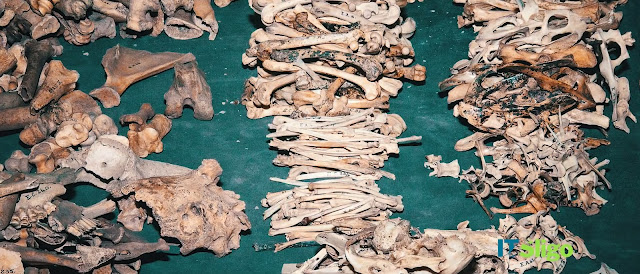A fascinating discovery in the darkness of a cave in County Clare has forced archaeologists to rewrite the history of Ireland. A bear bone found in the cave pushes back the date of human presence in Ireland by 2,500 years - to 12,500 years ago.
 |
| The cave near Ennis in Co. Clare in which the Paleolithic bear bone was found in 1903. |
"This is a hugely significant and exciting discovery," says Dr. Marion Dowd, an archaeologist at IT Sligo, who was co-discoverer with Dr. Ruth Carden of the National Museum of Ireland. "We've effectively pushed back the date of human occupation of the island of Ireland by two and a half thousand years. Until now, we knew that people had been here about 10,000 years ago, but now we've pushed that back into an earlier period - into the Paleolithic."
 |
| Dr. Marion Dowd of IT Sligo. |
"The bone that forms the centre of our project was one of those bones, and they commented on this bone in their excavation report. They remarked on the fact that it had these cut marks."
The bone is a patella, or knee bone, and belonged to an adult bear. Dr. Dowd says that the cut marks on the bone indicate someone trying to butcher the bear carcass.
"We're looking at a scenario where you have a bear and it's being butchered. They're cutting through the knee area, probably to pull out the tendons."She said that the "butcher" was likely to have been inexperienced because there were seven or eight cut marks on the bone and they were seemingly having difficulty cutting through the area.
 |
| The Paleolithic bear bone with linear cut marks. |
"This was very exciting," said Dr. Dowd, adding that it was "completely unexpected". For the purpose of confirmation, a second sample was extracted from the bear bone and sent to Oxford University, whose radiocarbon dating laboratory "sent back exactly the same result".
Now that they knew the age of the bone, they wanted to confirm that the cut marks on the bone were contemporaneous with the bone itself, and not something that was added years, or perhaps centuries, later. Three specialists independently examined the cut marks. All three experts agreed that the marks were made with a "sharp implement" and that they had been made "on fresh bone". The bear bone was butchered soon after death.
The discovery changes the history books, and pushes back the earliest date of known occupation of Ireland to 10500BC. There have been problems with identifying remains from the Paleolithic era - primarily due to the action of glaciers during the Ice Age, which had the effect of scouring a lot of evidence away. The melt waters at the end of the Ice Age would also have washed a lot of material away.
 |
| Thousands of animal bones were found in Alice and Gwendoline Cave in County Clare in 1903. |
Dr. Dowd said scientists and archaeologists had been looking for evidence of Paleolithic human activity since the 1860s.
Excitingly, there may be the prospect of a return to the cave, where some archaeological digging of the sediments there might reveal further tantalising clues to Ireland's very ancient past.
 |
| This one sample of bone rewrites the history of Ireland and adds 2,500 years to its human story. |

How did the "butcher" create such evenly parallel lines? It could be art or something else.
ReplyDeleteThat is an extremely good question and an excellent observation. If you consider that the "cutting" was done with a stone tool, then one would imagine these parallel score marks would take a bit of care - this does not look like the work of an inexperienced butcher. Maybe the experts who studied the stone are seeing something we don't see?
Deletehmmmmm
ReplyDelete